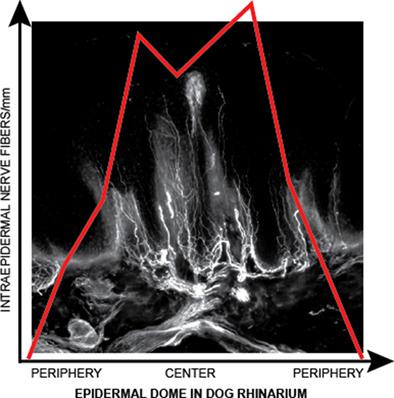当前位置:
X-MOL 学术
›
J. Morphol.
›
论文详情
Our official English website, www.x-mol.net, welcomes your
feedback! (Note: you will need to create a separate account there.)
Rhinarium skin structure and epidermal innervation in selected mammals
Journal of Morphology ( IF 1.5 ) Pub Date : 2021-01-22 , DOI: 10.1002/jmor.21313 Inga Tuminaite 1 , Ronald H H Kröger 1
Journal of Morphology ( IF 1.5 ) Pub Date : 2021-01-22 , DOI: 10.1002/jmor.21313 Inga Tuminaite 1 , Ronald H H Kröger 1
Affiliation

|
The glabrous skin around the nostrils in mammals is called a rhinarium or planum nasale. Rhinarium skin has multiple epidermal domes that are generally assumed to form a tactile surface. The rhinarium is innervated by a branch of the trigeminal nerve which is associated with stimuli such as touch, chemical irritants and temperature. In this study, our aim was to correlate variation in rhinarium skin sensory innervation with different feeding behaviors while also covering a broad systematic spectrum. Using histological and immunohistological methods, we studied skin morphology, nerve fiber density and nerve fiber distribution in the rhinarium epidermal domes of four species: cow, ring-tailed lemur, brown bear, and dog, that all exhibit different feeding behaviors. All species share similar traits in rhinarium skin morphology, but glands were only found in cow rhinarium skin. The most substantial differences were observed in the innervation pattern. Mechanosensory skin organs were found only in the ring-tailed lemur. Dog epidermal domes possess a pronounced central dermal papilla containing a nerve bundle in its top, close to the skin surface, possibly for detecting temperature. The abundance of free epidermal nerve fibers in epidermal domes of all species, suggest that the rhinarium skin is a sensory surface, that can be used to detect fine touch, chemical irritants or temperature. In the species where the whole epidermal dome was examined, the intraepidermal nerve fiber density is higher in the central part of the domes. The nerve distribution and the central positioning of a single gland duct in cow and the dermal papilla top organ in dog indicates that each epidermal dome can be considered a functional unit. The observed differences in innervation hint at different sensory functions of rhinaria in mammals that may be correlated to feeding behavior.
中文翻译:

选定哺乳动物的鼻皮肤结构和表皮神经支配
哺乳动物鼻孔周围的无毛皮肤称为鼻腔或鼻腔。Rhinarium 皮肤有多个表皮圆顶,通常被认为形成一个触觉表面。鼻腔由三叉神经的一个分支支配,该分支与诸如触摸、化学刺激物和温度之类的刺激有关。在这项研究中,我们的目的是将鼻皮肤感觉神经支配的变化与不同的进食行为相关联,同时还涵盖广泛的系统范围。我们使用组织学和免疫组织学方法研究了四种动物的鼻腔表皮圆顶的皮肤形态、神经纤维密度和神经纤维分布:牛、环尾狐猴、棕熊和狗,它们都表现出不同的摄食行为。所有物种在rhinarium皮肤形态上都有相似的特征,但腺体仅在牛鼻皮肤中发现。在神经支配模式中观察到最显着的差异。仅在环尾狐猴中发现了机械感觉皮肤器官。狗的表皮圆顶具有明显的中央真皮乳头,其顶部含有神经束,靠近皮肤表面,可能用于检测温度。所有物种的表皮圆顶中丰富的游离表皮神经纤维表明,鼻腔皮肤是一个感觉表面,可用于检测精细触摸、化学刺激物或温度。在检查整个表皮圆顶的物种中,圆顶中央部分的表皮内神经纤维密度较高。牛的单个腺管和狗的真皮乳头顶部器官的神经分布和中央位置表明每个表皮圆顶都可以被认为是一个功能单元。观察到的神经支配差异暗示哺乳动物鼻炎的不同感觉功能可能与进食行为有关。
更新日期:2021-01-22
中文翻译:

选定哺乳动物的鼻皮肤结构和表皮神经支配
哺乳动物鼻孔周围的无毛皮肤称为鼻腔或鼻腔。Rhinarium 皮肤有多个表皮圆顶,通常被认为形成一个触觉表面。鼻腔由三叉神经的一个分支支配,该分支与诸如触摸、化学刺激物和温度之类的刺激有关。在这项研究中,我们的目的是将鼻皮肤感觉神经支配的变化与不同的进食行为相关联,同时还涵盖广泛的系统范围。我们使用组织学和免疫组织学方法研究了四种动物的鼻腔表皮圆顶的皮肤形态、神经纤维密度和神经纤维分布:牛、环尾狐猴、棕熊和狗,它们都表现出不同的摄食行为。所有物种在rhinarium皮肤形态上都有相似的特征,但腺体仅在牛鼻皮肤中发现。在神经支配模式中观察到最显着的差异。仅在环尾狐猴中发现了机械感觉皮肤器官。狗的表皮圆顶具有明显的中央真皮乳头,其顶部含有神经束,靠近皮肤表面,可能用于检测温度。所有物种的表皮圆顶中丰富的游离表皮神经纤维表明,鼻腔皮肤是一个感觉表面,可用于检测精细触摸、化学刺激物或温度。在检查整个表皮圆顶的物种中,圆顶中央部分的表皮内神经纤维密度较高。牛的单个腺管和狗的真皮乳头顶部器官的神经分布和中央位置表明每个表皮圆顶都可以被认为是一个功能单元。观察到的神经支配差异暗示哺乳动物鼻炎的不同感觉功能可能与进食行为有关。











































 京公网安备 11010802027423号
京公网安备 11010802027423号